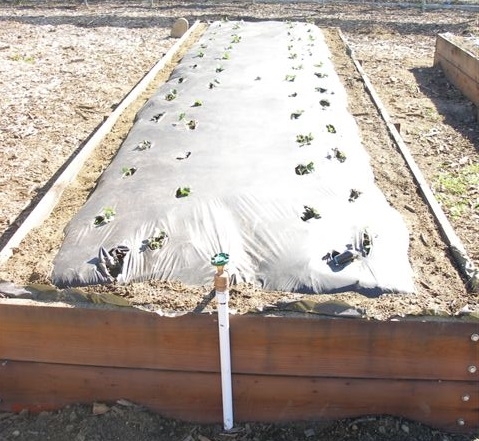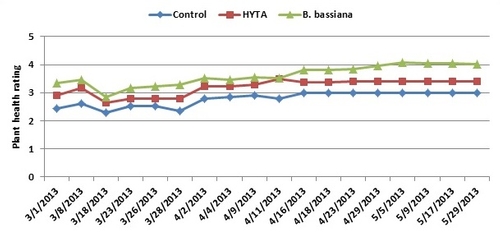Fungi such as Beauveria bassiana, Isaria fumosorosea, Metarhizium brunneum are pathogenic to mites and insects and are primarily used for pest management. Some of these are known to endophytically colonize plants and offer protection against arthropod pests feeding on those plants. Some studies have indicated that entomopathogenic fungi can also provide protection against plant pathogens.
In an effort to explore the endophytic potential of entomopathogenic fungi for strawberry pest management, studies were conducted in 2010 using commercial and California isolates of B. bassiana and M. brunneum where B. bassiana successfully colonized strawberry plants and persisted for up to 9 weeks in various plant tissues. Observations during this study suggested that endophytic entomopathogenic fungi could be aiding in plant health probably through mycorrhizal activity by improving water and nutrient absorption. Based on these observations, a small study was conducted to evaluate the impact of B. bassiana on strawberry plant health in comparison with a commercial product intended to promote plant growth, health, and yield.
This study was conducted in collaboration with Los Angeles County Pitchess Detention Center where inmates assisted in taking care of the plants and collecting data. As a part of the MERIT (Maximising Education Reaching Individual Transformation) Masters program, some inmates were selected to participate in this project. Since this was the first project in such collaboration, a simple experiment was designed for easy execution and data collection.
Treatments included i) Untreated control, ii) HYTA – which contains soil-based microorganisms that enhance nitrogen absorption, solubilize nutrients, and build soil organic matter, and iii) B. bassiana (Mycotrol –O). Transplants of the strawberry variety Monterey were treated by applying HYTA or B. bassiana to the root system in transplant treys. Planting was done 48 hours after treatment in 20X5X2' raised beds. Plants were regularly watered and fertilized with fish emulsion. Plant health was monitored for about three months starting from 4 weeks after planting. Plants were periodically observed and their health was rated on a scale of 0-5 where 0= dead, 1=weak, 2 and 3=moderate, 4=good, and 5=very good.
Strawberry plants were grown in 20X5X2' wooden beds. (Photo by Adrianne Ferree)
Except for a few aphids on some plants, the trial did not have any pest infestations. Plants treated with B. bassiana were rated higher than untreated control or those treated with HYTA throughout the observation period although differences were not statistically significant on all observations dates. While the plant health rating ranged from 2.3 to 3.0 for untreated control, it was between 2.6 and 3.5 for those treated with HYTA and 2.9 to 4.1 for those treated with B. bassiana. The average seasonal health rating was 2.8, 3.2, and 3.6 for untreated, HYTA, and B. bassiana, respectively. Fruit yield could not be monitored due to some technical difficulties.
Strawberry plant health from treating with HYTA and B. bassiana compared to untreated control
Beneficial microorganisms establish symbiotic relationship with plants and serve as extended root system improving the absorption of nutrients and moisture. By colonizing the roots and other plant tissues, they can also provide protection against plant pathogens. Several commercial formulations of fungus and bacteria based beneficial organisms are currently available for use on various crops. This preliminary study demonstrates that B. bassiana promotes plant health and can play an important role in crop production in addition to the primary role of pest management. Additional studies can further explore the potential of entomopathogenic fungi in promoting plant growth and improving yield as well as providing protection against pests and diseases.
Adrianne Ferree, Assistant Director, Jail Enterprises Unit collaborated in this project with the support of Chief Alex Yim. One of the two inmates who participated in this project took an online Plant Science course and used this study as his class project. He intends to pursue agronomy after his release. It is a great experience for me to be involved in the Maximizing Education Reaching Individual Transformation (MERIT) Masters program and introduce agricultural research to the inmates.
Acknowledgements: Thanks to Mike Fahner, Cedar Point Nursery for providing transplants and Joe Coelho, DB Specialty Farms for providing drip tapes and plastic mulch.
http://ucanr.edu/articlefeedback
References
Bisutti, I. L., S. Steen, and D. Stephan. 2013. Does Metarhizium anisopliae influence strawberries in presence of pest and disease? XLVI Annual meetings of the Society for Invertebrate Pathology, August 11-15, Pittsburgh, PA.
Dara, S.K. and S. R. Dara. 2010. Endophytic colonization of entomopathogenic fungi in strawberry plants. XLIII Annual meetings of the Society for Invertebrate Pathology, July 11-15, 2010, Trabzon, Turkey.
Dara, S. K., S. R. Dara,. and S. S. Dara. 2013. Exploring the potential of Beauveria bassiana and azadirachtin for managing strawberry pests. Proceedings of the II International Strawberry Congress, September 4-6, 2013, Antwerp, Belgium.
Miller T.C., W. D. Gubler, F. F. Laemmlen, S. Geng, and D. M. Rizzo. 2004. Potential for using Lecanicillium lecanii for suppression of strawberry powdery mildew, Biocon. Sci. Technol., 14: 215-220.
Ownley, B.H., R.M. Pereira, W. E. Klingeman, N.B. Quigley, and B. M. Leckie. 2004. Beauveria bassiana, a dual purpose biocontrol organism, with activity against insect pests and plant pathogens. Lartey, R.T., Caesar, A.J., editors. Research Signpost, Kerala, India. Emeging Concepts in Plant Health Management. 2004. p. 255-269.


